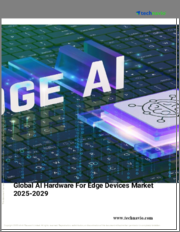
|
시장보고서
상품코드
1722791
인공지능(AI) 칩 시장 규모, 점유율, 동향, 예측 : 칩 유형, 기술, 프로세싱타입, 용도, 업계, 지역별(2025-2033년)Artificial Intelligence Chip Market Size, Share, Trends and Forecast by Chip Type, Technology, Processing Type, Application, Industry Vertical, and Region 2025-2033 |
||||||
인공지능(AI) 칩 세계 시장 규모는 2024년 237억 달러에 달했습니다. 향후 IMARC Group은 2033년에는 1,735억 달러에 달하고, 2025년부터 2033년까지 24.8%의 연평균 복합 성장률(CAGR)을 보일 것으로 예측했습니다. 인공지능(AI) 칩 시장에서는 북미가 시장 점유율의 32.1%를 차지하며 압도적인 우위를 보이고 있습니다. 이 지역은 머신러닝의 급속한 발전, 클라우드 기반 용도에 대한 높은 수요, AI 스타트업에 대한 투자 증가, 다양한 산업에서 이러한 칩을 광범위하게 채택하고 있는 것이 원동력입니다.
인공지능(AI) 칩은 프로그래밍 프레임워크를 통해 머신러닝(ML) 워크로드를 실행하기 위해 특별히 설계되었습니다. 이러한 칩은 FPGA(Field-Programmable Gate Array), GPU(Graphics Processing Unit), ASIC(Application Specific Integrated Circuit)로 구성되어 있습니다. 또한, AI에 최적화된 기능으로 구성되어 있어 AI 알고리즘이 필요로 하는 계산이나 컴퓨팅 작업을 빠르게 처리할 수 있습니다. 이들은 소형 트랜지스터에 의존하고 있으며, 대형 트랜지스터에 비해 빠르게 동작하고 에너지 소비도 적습니다. 인간의 뇌에서 영감을 얻은 머신러닝(ML) 접근 방식인 인공신경망(ANN)을 사용하는 용도를 위해 설계되었습니다. 여러 정보 스트림을 동시에 처리하여 매우 복잡하고 역동적인 작업을 수행할 수 있습니다. 이 칩은 장치에서 로컬로 AI 프로그램을 실행할 수 있기 때문에 데이터를 저장하기 위해 클라우드에 의존할 필요가 없습니다. 자연어 처리(NLP), 컴퓨터 비전, 로봇 공학, 네트워크 보안을 제공하는 AI 칩은 전 세계 자동차, 정보기술(IT), 헬스케어, 소매업에 적용되고 있습니다.
인공지능(AI) 칩 시장 동향 :
현재 자동차 업계에서는 무인 자동차 제조 및 자율주행 기술의 L5 수준 달성을 위해 AI 기술 채택이 증가하고 있으며, 이는 시장 성장을 뒷받침하는 중요한 요소 중 하나가 되고 있습니다. 이와 더불어, 전 세계적으로 어려운 상황에서 다양한 작업을 수행하는 AI 지원 기계에 대한 수요가 증가하고 있습니다. 이와 더불어, 인간을 의식한 AI 시스템 개발에 대한 관심이 높아지고 있으며, 시장 전망은 긍정적입니다. 또한, 주요 업체들은 뇌 기능의 실제 뉴런에서 영감을 받은 기술을 개발하기 위해 뉴로모픽 연구 활동에 투자하고 있습니다. 또한, 차세대 AI 칩을 설계하기 위해 AI와 머신러닝(ML)을 활용하고 있으며, 이는 시장 성장에 기여하고 있습니다. 또한, 노트북, 데스크톱, 게임기 등 가전제품의 AI 칩에 대한 수요 증가는 업계 투자자들에게 유리한 성장 기회를 제공합니다. 이와는 별도로 전 세계적으로 컴퓨터 비전, 빅데이터, 증강현실(AR), 가상현실(VR) 등 다양한 산업에서 첨단 기술의 채택이 증가하고 있습니다. 이는 복잡한 문제를 해결하고 분석 계산을 수행하기 위한 양자 컴퓨팅 기술의 사용 증가와 함께 시장에 긍정적인 영향을 미치고 있습니다.
본 보고서에서 다룬 주요 질문
- 인공지능(AI) 칩이란 무엇인가?
- 인공지능(AI) 칩 시장 규모는?
- 2025-2033년 인공지능(AI) 칩 세계 시장 성장률 전망은?
- 인공지능(AI) 칩 세계 시장을 주도하는 주요 요인은?
- 칩 유형에 따른 인공지능(AI) 칩 세계 시장 주요 부문은?
- 세계 인공지능(AI) 칩 시장의 기술별 주요 부문은?
- 프로세싱 유형에 따른 인공지능(AI) 칩 세계 시장 주요 부문은?
- 인공지능(AI) 칩 세계 시장 주요 응용 분야는?
- 세계 인공지능(AI) 칩 시장의 주요 산업별 부문은 무엇인가?
- 인공지능(AI) 칩 세계 시장 주요 지역은?
- 세계 인공지능(AI) 칩 시장의 주요 기업은?
목차
제1장 서문
제2장 조사 범위와 조사 방법
- 조사 목적
- 이해관계자
- 데이터 소스
- 1차 정보
- 2차 정보
- 시장 추정
- 보텀업 접근
- 톱다운 접근
- 조사 방법
제3장 주요 요약
제4장 서론
- 개요
- 주요 업계 동향
제5장 세계의 인공지능(AI) 칩 시장
- 시장 개요
- 시장 실적
- COVID-19의 영향
- 시장 예측
제6장 시장 분석 : 칩 유형별
- 그래픽 프로세서
- ASIC
- FPGA
- CPU
- 기타
제7장 시장 분석 : 기술별
- System-on-Chip (SoC)
- System-In-Package (SIP)
- Multi-Chip Module
- 기타
제8장 시장 분석 : 프로세싱 타입별
- 엣지
- 클라우드
제9장 시장 분석 : 용도별
- 자연언어처리(NLP)
- 로봇공학
- 컴퓨터 비전
- 네트워크 보안
- 기타
제10장 시장 분석 : 업계별
- 미디어 및 광고
- 은행, 금융서비스 및 보험(BFSI)
- IT 및 통신
- 소매
- 헬스케어
- 자동차 및 운송
- 기타
제11장 시장 분석 : 지역별
- 북미
- 미국
- 캐나다
- 아시아태평양
- 중국
- 일본
- 인도
- 한국
- 호주
- 인도네시아
- 기타
- 유럽
- 독일
- 프랑스
- 영국
- 이탈리아
- 스페인
- 러시아
- 기타
- 라틴아메리카
- 브라질
- 멕시코
- 기타
- 중동 및 아프리카
- 시장 내역 : 국가별
제12장 SWOT 분석
- 개요
- 강점
- 약점
- 기회
- 위협
제13장 밸류체인 분석
제14장 Porter의 Five Forces 분석
- 개요
- 바이어의 교섭력
- 공급 기업의 교섭력
- 경쟁 정도
- 신규 진출업체의 위협
- 대체품의 위협
제15장 가격 분석
제16장 경쟁 구도
- 시장 구조
- 주요 기업
- 주요 기업 개요
- Advanced Micro Devices Inc.
- Huawei Technologies Co. Ltd.
- Intel Corporation
- LG Electronics Inc.(LG Corporation)
- Mediatek Inc.
- Micron Technology Inc.
- Mythic Inc.
- Nvidia Corporation
- NXP Semiconductors N.V.
- Qualcomm Technologies Inc
- SK hynix Inc.
- Toshiba Corporation
The global artificial intelligence chip market size was valued at USD 23.7 Billion in 2024. Looking forward, IMARC Group estimates the market to reach USD 173.5 Billion by 2033, exhibiting a CAGR of 24.8% during 2025-2033. North America exhibits a clear dominance in the artificial intelligence chip market with 32.1% of the market share. This region is driven by rapid advancements in machine learning, high demand for cloud-based applications, growing investments in AI startups, and widespread adoption of these chips across various industries.
Artificial intelligence (AI) chips are specially designed to run machine learning (ML) workloads through programming frameworks. They comprise field-programmable gate arrays (FPGAs), graphics processing units (GPUs), and application-specific integrated circuits (ASICs). They also consist of AI-optimized features, which can accelerate calculations and computing tasks required by AI algorithms. They rely on small transistors, which run faster and consume less energy as compared to large transistors. They are designed for applications that use artificial neural networks (ANN), which is a machine learning (ML) approach inspired by the human brain. They can execute tasks that are highly complex and dynamic by processing multiple streams of information simultaneously. They eliminate the need to rely on the cloud to store data, as these chips can run AI programs locally on the devices. As they offer natural language processing (NLP), computer vision, robotics, and network security, AI chips find applications in the automotive, information and technology (IT), healthcare, and retail industries across the globe.
Artificial Intelligence Chip Market Trends:
At present, the rising adoption of AI technology in the automotive industry to manufacture driverless cars and achieve the L5 level of autonomous technology represents one of the key factors supporting the growth of the market. Besides this, there is an increase in the demand for AI-enabled machines to perform various tasks in challenging situations around the world. This, along with the growing focus on developing human-aware AI systems, is offering a favorable market outlook. In addition, key players are investing in neuromorphic research activities to develop techniques inspired by the real neurons in the brain function. They are also utilizing AI and machine learning (ML) to design the next generation of AI chips, which is contributing to the growth of the market. Moreover, the increasing demand for AI chips in consumer electronics, such as laptops, desktops, and gaming consoles, is offering lucrative growth opportunities to industry investors. Apart from this, there is a rise in the employment of advanced technologies in various industries, such as computer vision, big data, augmented reality (AR), and virtual reality (VR), across the globe. This, coupled with the growing utilization of quantum computing technologies to tackle complicated issues and perform analytical computations, is positively influencing the market.
Key Market Segmentation:
Chip Type Insights:
- GPU
- ASIC
- FPGA
- CPU
- Others
Technology Insights:
- System-on-Chip (SoC)
- System-In-Package (SIP)
- Multi-Chip Module
- Others
Processing Type Insights:
- Edge
- Cloud
Application Insights:
- Natural Language Processing (NLP)
- Robotics
- Computer Vision
- Network Security
- Others
Industry Vertical Insights:
- Media and Advertising
- BFSI
- IT and Telecom
- Retail
- Healthcare
- Automotive and Transportation
- Others
Regional Insights:
- North America
- United States
- Canada
- Asia-Pacific
- China
- Japan
- India
- South Korea
- Australia
- Indonesia
- Others
- Europe
- Germany
- France
- United Kingdom
- Italy
- Spain
- Russia
- Others
- Latin America
- Brazil
- Mexico
- Others
- Middle East and Africa
- The report has also provided a comprehensive analysis of all the major regional markets, which include North America (the United States and Canada); Asia Pacific (China, Japan, India, South Korea, Australia, Indonesia, and others); Europe (Germany, France, the United Kingdom, Italy, Spain, Russia, and others); Latin America (Brazil, Mexico, and others); and the Middle East and Africa. According to the report, North America (the United States and Canada) was the largest market for artificial intelligence chip. Some of the factors driving the North America artificial intelligence chip market included the growing application in consumer electronics, integration of voice commands in various products, availability of several market players, etc.
Competitive Landscape:
- The report has also provided a comprehensive analysis of the competitive landscape in the global artificial intelligence chip market. Competitive analysis such as market structure, market share by key players, player positioning, top winning strategies, competitive dashboard, and company evaluation quadrant has been covered in the report. Also, detailed profiles of all major companies have been provided. Some of the companies covered include Advanced Micro Devices Inc., Huawei Technologies Co. Ltd., Intel Corporation, LG Electronics Inc. (LG Corporation), Mediatek Inc., Micron Technology Inc., Mythic Inc., Nvidia Corporation, NXP Semiconductors N.V., Qualcomm Technologies Inc, SK hynix Inc., Toshiba Corporation, etc. Kindly note that this only represents a partial list of companies, and the complete list has been provided in the report.
Key Questions Answered in This Report
- 1.What is artificial intelligence chip?
- 2.How big is the artificial intelligence chip market?
- 3.What is the expected growth rate of the global artificial intelligence chip market during 2025-2033?
- 4.What are the key factors driving the global artificial intelligence chip market?
- 5.What is the leading segment of the global artificial intelligence chip market based on the chip type?
- 6.What is the leading segment of the global artificial intelligence chip market based on technology?
- 7.What is the leading segment of the global artificial intelligence chip market based on processing type?
- 8.What is the leading segment of the global artificial intelligence chip market based on application?
- 9.What is the leading segment of the global artificial intelligence chip market based on industry vertical?
- 10.What are the key regions in the global artificial intelligence chip market?
- 11.Who are the key players/companies in the global artificial intelligence chip market?
Table of Contents
1 Preface
2 Scope and Methodology
- 2.1 Objectives of the Study
- 2.2 Stakeholders
- 2.3 Data Sources
- 2.3.1 Primary Sources
- 2.3.2 Secondary Sources
- 2.4 Market Estimation
- 2.4.1 Bottom-Up Approach
- 2.4.2 Top-Down Approach
- 2.5 Forecasting Methodology
3 Executive Summary
4 Introduction
- 4.1 Overview
- 4.2 Key Industry Trends
5 Global Artificial Intelligence Chip Market
- 5.1 Market Overview
- 5.2 Market Performance
- 5.3 Impact of COVID-19
- 5.4 Market Forecast
6 Market Breakup by Chip Type
- 6.1 GPU
- 6.1.1 Market Trends
- 6.1.2 Market Forecast
- 6.2 ASIC
- 6.2.1 Market Trends
- 6.2.2 Market Forecast
- 6.3 FPGA
- 6.3.1 Market Trends
- 6.3.2 Market Forecast
- 6.4 CPU
- 6.4.1 Market Trends
- 6.4.2 Market Forecast
- 6.5 Others
- 6.5.1 Market Trends
- 6.5.2 Market Forecast
7 Market Breakup by Technology
- 7.1 System-on-Chip (SoC)
- 7.1.1 Market Trends
- 7.1.2 Market Forecast
- 7.2 System-In-Package (SIP)
- 7.2.1 Market Trends
- 7.2.2 Market Forecast
- 7.3 Multi-Chip Module
- 7.3.1 Market Trends
- 7.3.2 Market Forecast
- 7.4 Others
- 7.4.1 Market Trends
- 7.4.2 Market Forecast
8 Market Breakup by Processing Type
- 8.1 Edge
- 8.1.1 Market Trends
- 8.1.2 Market Forecast
- 8.2 Cloud
- 8.2.1 Market Trends
- 8.2.2 Market Forecast
9 Market Breakup by Application
- 9.1 Natural Language Processing (NLP)
- 9.1.1 Market Trends
- 9.1.2 Market Forecast
- 9.2 Robotics
- 9.2.1 Market Trends
- 9.2.2 Market Forecast
- 9.3 Computer Vision
- 9.3.1 Market Trends
- 9.3.2 Market Forecast
- 9.4 Network Security
- 9.4.1 Market Trends
- 9.4.2 Market Forecast
- 9.5 Others
- 9.5.1 Market Trends
- 9.5.2 Market Forecast
10 Market Breakup by Industry Vertical
- 10.1 Media and Advertising
- 10.1.1 Market Trends
- 10.1.2 Market Forecast
- 10.2 BFSI
- 10.2.1 Market Trends
- 10.2.2 Market Forecast
- 10.3 IT and Telecom
- 10.3.1 Market Trends
- 10.3.2 Market Forecast
- 10.4 Retail
- 10.4.1 Market Trends
- 10.4.2 Market Forecast
- 10.5 Healthcare
- 10.5.1 Market Trends
- 10.5.2 Market Forecast
- 10.6 Automotive and Transportation
- 10.6.1 Market Trends
- 10.6.2 Market Forecast
- 10.7 Others
- 10.7.1 Market Trends
- 10.7.2 Market Forecast
11 Market Breakup by Region
- 11.1 North America
- 11.1.1 United States
- 11.1.1.1 Market Trends
- 11.1.1.2 Market Forecast
- 11.1.2 Canada
- 11.1.2.1 Market Trends
- 11.1.2.2 Market Forecast
- 11.1.1 United States
- 11.2 Asia-Pacific
- 11.2.1 China
- 11.2.1.1 Market Trends
- 11.2.1.2 Market Forecast
- 11.2.2 Japan
- 11.2.2.1 Market Trends
- 11.2.2.2 Market Forecast
- 11.2.3 India
- 11.2.3.1 Market Trends
- 11.2.3.2 Market Forecast
- 11.2.4 South Korea
- 11.2.4.1 Market Trends
- 11.2.4.2 Market Forecast
- 11.2.5 Australia
- 11.2.5.1 Market Trends
- 11.2.5.2 Market Forecast
- 11.2.6 Indonesia
- 11.2.6.1 Market Trends
- 11.2.6.2 Market Forecast
- 11.2.7 Others
- 11.2.7.1 Market Trends
- 11.2.7.2 Market Forecast
- 11.2.1 China
- 11.3 Europe
- 11.3.1 Germany
- 11.3.1.1 Market Trends
- 11.3.1.2 Market Forecast
- 11.3.2 France
- 11.3.2.1 Market Trends
- 11.3.2.2 Market Forecast
- 11.3.3 United Kingdom
- 11.3.3.1 Market Trends
- 11.3.3.2 Market Forecast
- 11.3.4 Italy
- 11.3.4.1 Market Trends
- 11.3.4.2 Market Forecast
- 11.3.5 Spain
- 11.3.5.1 Market Trends
- 11.3.5.2 Market Forecast
- 11.3.6 Russia
- 11.3.6.1 Market Trends
- 11.3.6.2 Market Forecast
- 11.3.7 Others
- 11.3.7.1 Market Trends
- 11.3.7.2 Market Forecast
- 11.3.1 Germany
- 11.4 Latin America
- 11.4.1 Brazil
- 11.4.1.1 Market Trends
- 11.4.1.2 Market Forecast
- 11.4.2 Mexico
- 11.4.2.1 Market Trends
- 11.4.2.2 Market Forecast
- 11.4.3 Others
- 11.4.3.1 Market Trends
- 11.4.3.2 Market Forecast
- 11.4.1 Brazil
- 11.5 Middle East and Africa
- 11.5.1 Market Trends
- 11.5.2 Market Breakup by Country
- 11.5.3 Market Forecast
12 SWOT Analysis
- 12.1 Overview
- 12.2 Strengths
- 12.3 Weaknesses
- 12.4 Opportunities
- 12.5 Threats
13 Value Chain Analysis
14 Porters Five Forces Analysis
- 14.1 Overview
- 14.2 Bargaining Power of Buyers
- 14.3 Bargaining Power of Suppliers
- 14.4 Degree of Competition
- 14.5 Threat of New Entrants
- 14.6 Threat of Substitutes
15 Price Analysis
16 Competitive Landscape
- 16.1 Market Structure
- 16.2 Key Players
- 16.3 Profiles of Key Players
- 16.3.1 Advanced Micro Devices Inc.
- 16.3.1.1 Company Overview
- 16.3.1.2 Product Portfolio
- 16.3.1.3 Financials
- 16.3.1.4 SWOT Analysis
- 16.3.2 Huawei Technologies Co. Ltd.
- 16.3.2.1 Company Overview
- 16.3.2.2 Product Portfolio
- 16.3.2.3 SWOT Analysis
- 16.3.3 Intel Corporation
- 16.3.3.1 Company Overview
- 16.3.3.2 Product Portfolio
- 16.3.3.3 Financials
- 16.3.3.4 SWOT Analysis
- 16.3.4 LG Electronics Inc. (LG Corporation)
- 16.3.4.1 Company Overview
- 16.3.4.2 Product Portfolio
- 16.3.4.3 Financials
- 16.3.4.4 SWOT Analysis
- 16.3.5 Mediatek Inc.
- 16.3.5.1 Company Overview
- 16.3.5.2 Product Portfolio
- 16.3.5.3 Financials
- 16.3.5.4 SWOT Analysis
- 16.3.6 Micron Technology Inc.
- 16.3.6.1 Company Overview
- 16.3.6.2 Product Portfolio
- 16.3.6.3 Financials
- 16.3.6.4 SWOT Analysis
- 16.3.7 Mythic Inc.
- 16.3.7.1 Company Overview
- 16.3.7.2 Product Portfolio
- 16.3.8 Nvidia Corporation
- 16.3.8.1 Company Overview
- 16.3.8.2 Product Portfolio
- 16.3.8.3 Financials
- 16.3.8.4 SWOT Analysis
- 16.3.9 NXP Semiconductors N.V.
- 16.3.9.1 Company Overview
- 16.3.9.2 Product Portfolio
- 16.3.9.3 Financials
- 16.3.9.4 SWOT Analysis
- 16.3.10 Qualcomm Technologies Inc
- 16.3.10.1 Company Overview
- 16.3.10.2 Product Portfolio
- 16.3.10.3 Financials
- 16.3.10.4 SWOT Analysis
- 16.3.11 SK hynix Inc.
- 16.3.11.1 Company Overview
- 16.3.11.2 Product Portfolio
- 16.3.11.3 Financials
- 16.3.11.4 SWOT Analysis
- 16.3.12 Toshiba Corporation
- 16.3.12.1 Company Overview
- 16.3.12.2 Product Portfolio
- 16.3.12.3 Financials
- 16.3.12.4 SWOT Analysis
- 16.3.1 Advanced Micro Devices Inc.



















